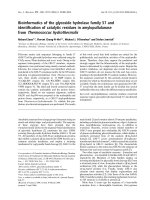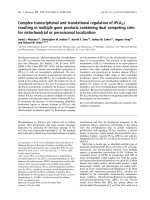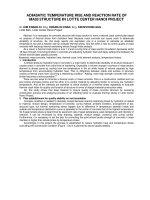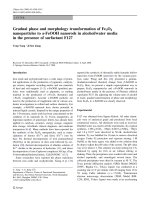hydrate formation and phase transformation of risedronate monosodium in solution crystallization
Bạn đang xem bản rút gọn của tài liệu. Xem và tải ngay bản đầy đủ của tài liệu tại đây (5.05 MB, 127 trang )
Dissertation for the Degree of Master of Science
HYDRATE FORMATION AND PHASE
TRANSFORMATION OF RISEDRONATE
MONOSODIUM IN SOLUTION
CRYSTALLIZATION
Department of Chemical Engineering
Graduate School
Hanbat National University
by
Nguyen, Thi Nhat Phuong
Advisor: Prof. Kwang Joo Kim
February, 2009
碩士學位論文
용액결정화에서리세드로네이트의상변환및
수화물형성특성
HYDRATE FORMATION AND PHASE
TRANSFORMATION OF RISEDRONATE
MONOSODIUM IN SOLUTION
CRYSTALLIZATION
한밭大學校産業大學院
化學工學科
Nguyễn Thị Nhật Phương
2009 년2 월
Hydrate Formation and Phase Transformation
of Risedronate Monosodium in Solution
Crystallization
Advisor: Prof Kwang Joo Kim
Thesis submitted in partial fulfillment of the requirement for the
degree of Master of Science
November, 2008
Department of Chemical Engineering
Graduate School
Hanbat National University
Nguyen Thi Nhat Phuong
용액결정화에서 리세드로네이트의 상변환 및
수화물 형성 특성
HYDRATE FORMATION AND PHASE TRANSFORMATION
OF RISEDRONATE MONOSODIUM IN SOLUTION
CRYSTALLIZATION
指導敎授 김 광 주
이 論文을 工學碩士學位
請求論文으로 제출함
2008 년 11 월
한밭大學校 産業大學院
化學工學科
Nguyễn Thị Nhật Phương
Nguyen Thi Nhat Phuong 의 碩士學位 論文을
認准함
審査委員長 ________________________(인)
審査 委 員 ________________________(인)
審査 委 員 ________________________(인)
2008 년 12 월
한밭大學校 産業大學院
To Approve the Submitted Dissertation
for the Degree of Master of Science
by Nguyen, Thi Nhat Phuong
Title: Hydrate Formation and Phase Transformation of
Risedronate Monosodium in Solution Crystallization
December, 2008
Chairman of Committee Prof. Dr. Seong Uk Hong
Hanbat National University
Member of Committee Prof. Dr. Kwang Joo Kim
Hanbat National University
Member of Committee Dr. Seong Hoon Jeong
LG Life Sciences Co., Ltd.
Graduate School
Hanbat National University
i
CONTENTS
CONTENTS I
LIST OF TABLES IV
LIST OF FIGURES V
NOMENCLATURES VIII
ABBREVIATIONS IX
ABSTRACT (IN KOREAN) X
I. INTRODUCTION 1
II. BACKGROUND 4
1. Pharmaceutical solids 4
2. Hydrate 10
3. Crystallization 18
3.1. Nucleation 18
3.2. Crystal growth 24
3.3. Phase transformation 25
3.4. Process control 29
III. AIM OF THE STUDY 38
IV. KINETIC STUDY ON THE HEMI-PENTA HYDRATE RS IN BATCH
COOLING CRYSTALLIZATION 39
1. Introduction 39
2. Experiment 40
3. Results and discussions 42
3.1. Solubility and the crystallization of hemi-penta hydrate Risedronate
monosodium 42
3.2. In-situ monitoring the crystallization by FBRM 46
ii
3.3. Effect of initial solution concentration 48
3.4. Kinetic of crystallization 50
4. Conclusions 57
V. SOLVENT-MEDIATED PHASE TRANSFORMATION FROM HEMI-
PENTA TO MONO HYDRATE OF RS IN SUSPENSION 58
1. Introduction 58
2. Experiment 59
3. Results and discussions 62
3.1. Characterization of solid forms and solid composition 62
3.2. In-situ monitoring the phase transformation 65
3.3. Phase transformation kinetic 68
3.4. Concentration of solution 70
3.5. Effect of mono hydrate seeding 72
3.6. Effect of temperature 73
3.7. Effect of agitation rate 75
4. Conclusions 77
VI. DEHYDRATION OF MONO HYDRATE FORM OF RS 78
1. Introduction 78
2. Experiment 79
3. Results and discussions 81
3.1. Characterization of monohydrate and anhydrous of Risedronate monosodium 81
3.2. In-situ measurement in the phase transformation 82
3.3. Kinetic of phase transformation 87
3.4. The effect of water content 90
3.5. The effect of temperature 92
3.6. The effect of agitation rate 93
4. Conclusions 95
VII. CONCLUSIONS 96
iii
VIII.APPENDIX 98
IX. REFERENCES 100
ABSTRACT 107
ACKNOWLEDGEMENT
iv
LIST OF TABLES
Table II-1. Various physical properties of pharmaceutical solids and
pharmaceutical performance 8
Table II-2. The examples of API polymorphism 9
Table II-3. CSD statistics of crystal solids 10
Table II-4. The similarities and differences between polymorphs and hydrates 14
Table II-5. Classification of crystalline hydrates 16
Table II-6. Driving force for nucleation and growth 19
Table II-7. Phase transition and their underlying mechanism 28
Table II-8. List of analytical techniques for solid-state characterization 34
_________________________
Table IV-1. Solubility (C
*
) data of hemi-penta and mono hydrate RS in water 43
Table IV-2. Summarized experimental conditions 43
Table IV-3. Calculation of the shape factor, molecular volume and interfacial free
energy 55
_________________________
Table V-1. The crystal structure data of mono and hemi-penta hydrate 62
Table V-2. Summary the function of induction, phase transformation time and time
for the monohydrate crystallization according to temperature 75
_________________________
Table VI-1. Results of kinetic parameters 90
_________________________
Table VIII-1. The relation ship of ultrasonic velocity with concentration and solid
fraction 99
v
LIST OF FIGURES
Figure I-1. The molecule structure of hydrate of monosodium Risedronate 2
_________________________
Figure II-1. Schematic of pharmaceutical solid 4
Figure II-2. Effect of hydration on the physical and pharmaceutical properties of
drug 12
Figure II-3. Stability phase diagram for stoichiometric hydrates at constant
temperature 17
Figure II-4. The course of crystallization, nucleation and growth mechanism 18
Figure II-5. Supersaturation and methods to create supersaturation 19
Figure II-6. The solubility – supersolubility diagram 20
Figure II-7. The desupersaturation curve 24
Figure II-8. The general view of controlling crystal form in crystallization 30
Figure II-9. The measuring method of Liquisonic 35
Figure II-10. Focused Beam Reflectance and Particle Vision Measurement 36
_________________________
Figure IV-1. The Schematic diagram for experimental apparatus 41
Figure IV-2. The solubility of hemi-penta and mono hydrate RS in water 44
Figure IV-3. The PXRD patterns of the solid product obtained at various initial
concentrations (C
o
) in crystallization at T
c
=298K and that of hemi-penta
hydrate RS referred in patent WO 03/086355 45
Figure IV-4. Typical plot of the total particle number and the mean length chord of
particle with elapsed time at T
c
=298K, C
o
=0.10g/g 46
Figure IV-5. Variation of particle size distribution during crystallization of hemi-
penta hydrate RS at C
o
=0.10 g/g and T
c
=298K 47
Figure IV-6 The influence of initial concentration (C
o
) on shape of hemi-penta
hydrate RS at T
c
=298K 49
vi
Figure IV-7. Particle size distribution at initial solution concentrations (C
o
) of 0.08,
0.10, 0.12 and 0.13 g/g at T
c
=298K 49
Figure IV-8. Total number of particle according to elapsed time at various initial
solution concentrations (C
o
), T
c
=298K 51
Figure IV-9. The plot of induction time against with initial solution concentration (C
o
)
in crystallization at T
c
=298K 53
Figure IV-10. Plot of lnt
ind
versus (lnS
max
)
2
for hemi-penta hydrate RS in
crystallization at T
c
=298K 54
Figure IV-11. Variation of median crystal size with elapsed time corresponding to
various initial solution concentrations (C
o
) at T
c
= 298K 56
Figure IV-12. The plot of maximum crystal growth rate (G
max
) with maximum
allowable supersaturation (
Δ
C
max
) 56
_________________________
Figure V-1. The experimental apparatus 61
Figure V-2: Characterization of mono and hemi-penta hydrates: DSC & TGA curve
(a), PXRD patterns (b), SEM (left side of (c)) and microscopic (right side
of (c)) image. 64
Figure V-3. The solubility curves of hydrate forms 66
Figure V-4. The change of ultrasonic velocity against with time, PXRD patterns &
microscopic images at T=346.5K, agitation rate of 300rpm 67
Figure V-5. The mass fraction and ln(t-t
ind
) & ln[-ln(1-x)]] plot at 346.5K 69
Figure V-6. Effect of solution concentration and solid fraction on ultrasonic velocity
(a) and calibration of ultrasonic velocity (b) 70
Figure V-7. The change of solution concentration with elapsed time 72
Figure V-8. The effect of mono hydrate crystal seed on the phase transformation 73
Figure V-9. The ultrasonic velocity curves of seeded system experiment at various
temperatures 74
Figure V-10. The effect of temperature on the transformation 75
Figure V-11. The lnt
ind
& ln
Δ
C
max
plot 76
Figure V-12. The effect of agitation rate 77
vii
Figure VI-1. Schematic diagram for experimental apparatus 80
Figure VI-2. The DSC, TGA curves (a); PXRD patterns (b) and SEM images (c) of
monohydrate and anhydrous form of RS 82
Figure VI-3. The trend of particle number and particle size according to time in
suspension at water C
w
= 0.10 (wt %), T = 334.3 K and
ω
= 400rpm 83
Figure VI-4. The particle distributions (a), PXRD patterns (b) and PVM images (c) of
samples during the transformation in suspension at C
w
= 0.10 (wt %),
T = 334.3 K and
ω
= 400rpm 85
Figure VI-5. The SEM images of sample during the phase transition in suspension at
C
w
= 0.10 (wt %), T = 334.3 K and
ω
=400rpm 86
Figure VI-6. Peak selection and relationship between peak area fraction & weight
fraction of monohydrate 88
Figure VI-7. Solid composition during phase transformation 88
Figure VI-8. Diagram of total transformation time according to water content 92
Figure VI-9. Diagram of total transformation time according to temperature 93
Figure VI-10. Diagram of total transformation time according to agitation rate 94
_________________________
Figure VIII-1. The peak selection and PXRD calibration data 98
viii
NOMENCLATURES
Symbol name unit
A surface area of crystal m
2
a activity -
B nucleation rate -
C concentration g/g
C* solubility g/g
g growth order
G linear growth rate m s
-1
G Gibbs free energy kJ mol
-1
H enthalpy kJ mol
-1
k compressibility Pa
-1
k
n
rate constant of nucleation s
-1
k
g
rate constant of crystal growth s
-1
L crystal size m
m, M mass g
n nucleation order -
P pressure Pa
r radius m
R
g
mass growth rate kg m
2
s
-1
S supersaturation ratio / -
S entropy kJ mol
-1
t (residence) time s, hr
T temperature K
v ultrasonic velocity m s
-1
Greek letters
α, f
v
volume shape factor -
β , f
s
surface shape factor -
γ interfacial free energy N m
-1
ρ density kg m
-3
σ relative supersaturation -
mean linear growth velocity ms
-1
υ volume fraction -
ω agitation rate rpm
Indices
* equilibrium
f initial or first state
s second or final state
Nomenclature
g growth
ind induction
lp latent period
n nucleation, nucleus
r relaxation
s saturation/surface/solution
ix
ABBREVIATIONS
API Active Pharmaceutical Ingredients
ATR-FTIR Attenuated Total Reflectance Fourier Transform Infrared
CSD Cambridge Structural Database /or Crystal Size Distribution
DSC Differential Scanning Calorimetry
DTA Differential Thermal Analysis
FBRM Focused Beam Reflectance Measurement
HSM Hot State Microscopy
IR Mix-Infrared
MS Mass Spectroscopy
NIR Near-Infrared
PAT Process Analysis Technique
ppm part per million
PVM Particle Vision Microscope
PXRD Powder X-Ray Diffraction
rpm Revolution Per Minute
RH Relative Humidity
RS Risedronate Monosodium
SEM Scanning Electron Microscopy
SSNMR Solid-State Nuclear Magnetic Resonance
TGA Thermo-Gravimetric Analysis
TG/IR Thermogravimetry and Infrared Spectroscopy
T
tr
transition temperature
wt weight
v volume
w water
x
국문요약(Abstract in Korean)
용액결정화에서리세드로네이트의상변환및수화물형성특성
논문제출자: 윙타이냑풍
지도교수: 김광주
리세드로네이트 2.5 수화물의 결정화 메커니즘이 냉각결정화에 의하여
연구되었다. 물에서 리세드로네이트 2.5 수화물의 결정화에서 용해도, 유도기간,
핵생성및결정성장이FBRM 에의하여분석되었다.유도기간과과포화의관계는
핵생성의 메커니즘을 이해하기 위하여 분석되었다. 균일 및 불균일 핵생성
메커니즘이 과포화 관점에서 조사되었다. 핵생성 연구결과로부터
2.5 수화물의
계면장력이 실험적으로 결정되어졌다. 결정성장 메커니즘은 일차 및 이차원
성장의혼합모델로해석되었다.
리세드로네니트 2.5 수화물을 1 수화물로 변환하는 연구가 2.5 수화물 결정의
슬러리용액하에서결정화에의하여수행되었다.초음파속도의측정및PXRD 을
동시에 사용하여 수화물의 변환이 실시간으로 결정되었다. 농도 및 고체분율의
초음파 속도에 미치는 영향을 측정하여 이들의 상관관계식을 도출하였다
.
xi
이로부터수화물조성,용액농도,과포화도및결정화정도가결정되었다.수화물
형태의변환에미치는종,교반속도및온도의영향이또한고려되었다.
메탄올‐물혼합물에서리세드로네니트1 수화물을무수물로변환하는연구가
수행되었다. 침상모양의 1 수화물이 다면체의 무수물로 변화하는 과정을 실시간
측정방법인 FBRM및 PVM 에 의하여 관측되었다.고체의
결정형은 SEM, PXRD,
DSC, TGA 등에 의하여 확인되었다. 리세드로네니트 1 수화물을 무수물로 상
변환에 대한 메커니즘이 분석되었다. 혼합용매에서 물의 함량이 무수물과
1 수화물의안정성을결정하는주요인자이었다.상변환에요구되는시간은온도
및교반속도에의하여영향을받았다.
1
I. INTRODUCTION
As mentioned in many previous studies, the different solid states (polymorph,
solvate, hydrate, salt, cocrystal) of active pharmaceutical ingredients (APIs) have
various physical- physicochemical properties, which display a significant role in drug
performance as well as drug manufacturing
1-5
. Recently, the understanding, monitoring
and controlling solid-state form are necessary and challenge task.
Bisphosphonates such as 3-pyridyl-1-hydro-cyethylidene-1,1-bisphosphonic acid
(Risedronate) have been used for the treatment of diseases of bone and calcium
metabolism. These diseases include oste-oporosis, hyperparathyroidism, hypercalcemia
of malignancy, ostolytic bone metastases, myosistis ossifcans progressive, calcinoitis
universalis, arthritis, neuritis, bursitis, tendonitis and other inflammatory conditions.
Paget’s disease and heterotropic ossification are currently successfully treated with both
EHDP (ethane-1-hydroxy-1,1-diphosphonic acid) and Risedronate. The
bisphosphonates tend to inhibit the resorption of bone tissue, which is beneficial to
patients suffering from excessive bone loss. However, in spite of certain analogies in
biological activity, all bisphosphonates do not exhibit the same degree of biological
activity. Some bisphosphonates have serious drawbacks with respect to the degree of
toxicity in animals and the tolerability or negative side effects in human. The salt and
hydrate forms of bisphosphates alter both their solubility and their bioavailability.
Sodium and Calcium Risedronate are two kind of Risedronate salt often used
6-8
.The
structure of monosodium Risedronate (RS) is shown in figure I.1. It is known in the
literature that Risedronate mono-sodium commonly exists in anhydrous form and
hydration states which have not only different morphologies but also various physical
properties. In crystallization process, various hydrates containing either stoichiometric
or nonstoichiometric amounts of water could be crystallized from the aqueous solution.
By adjusting the degree of supersaturation, crystallization mode (cooling, drowning out,
evaporations, ect.) and operating crystallization conditions, mono, hemi-penta and penta
hydrates were selectively crystallized. In reported patents, various hydrate and
anhydrous forms were obtained by crystallization from risedronic acid and sodium
2
hydroxide using water as solvent or mixture solvent of water and an alcohol, especially
ethanol, methanol and isopropanol (IPA)
6,7,9,10
. Furthermore, it was also recognized that
there was the transformation between hydrate forms by treating slurries in water,
ethanol and IPA or mixture of water and ethanol; exposing to the high relative humidity
environment or heating at fit temperature
9,11.12
. However, the controlling of these
polymorphs is still complicated and unsolved problem in crystallization and particularly
pharmaceutical crystallization research.
To manage the solid form, it is necessary to completely understand the kinetic and
mechanism of the crystallization of these polymorphs, which is not clear until now and
need to be studied carefully in the future. It is known that the crystallization of various
solid forms is composed of competitive nucleation, growth, and the transformation from
a meta-stable to stable form. To select a desire form, the mechanism of each elementary
step in the crystallization process need to be made clear in the relation to the operational
conditions and the key controlling factor such as: solubility, supersaturation,
temperature, stirring rate, mixing rate of reactant solutions, seed crystals, solvent,
additives, interface tension, pH, etc.
13
O
OH
OH
P
ONa
O
OH
N
OH
Figure I.1. The molecule structure of hydrate of monosodium Risedronate
So, to understand the mechanism of habit modification, the formation of various
hydrates and polymorphs as well as the transformation of them of Risedronate, it is
necessary to study the kinetics of crystallization by measuring the nucleation rate and
the growth rate which are the function of supersaturation. The in-situ measurements,
inline techniques such as Focused Beam Reflectance Measurement (FBRM), PVM
(Paticle Vision Microscope), Ultrasonic velocity measurement, Attenuated Total
Reflectance-Fourier Transform Infrared (ATR-FTIR) spectroscopy, Raman and near
infrared (NIR) measurement combine with the offline polymorph analysis technique
n.H
2
O
n= 0: anhydrous
n=0.5: hemi hydrate
n= 1: mono hydrate
n=2: dihydrate
n=2.5: hemi-penta hydrate
n=5: penta hydrate
3
concluding: crystallography: X-Ray diffraction (single crystal and powder);
morphology: polarizing optical microscopy, thermal microscopy, SEM; thermal
method: TGA, DTA, DSC; molecular motion-vibrational spectroscopy: FTIR, Raman;
NMR, etc. are very powerful techniques which can aid to identify and control the
polymorphs and hydrate forms during crystallization process nowadays.
In this study, the process analysis technique (PAT) including Ultrasonic velocity
measurement, FBRM and PVM was used together with offline analysis technique to
find the kinetic of hydrate formation; the phase transformation between hydrate forms
in suspension of solid hydrate in saturated aqueous solution as well as the dehydration
in suspension of hydrate in non-aqueous media.
4
II. BACKGROUND
1. Pharmaceutical solids
1.1. Definitions
Active pharmaceutical ingredients (APIs) are frequently delivered to the patient in
the solid-state as part of an approved dosage form (e.g., tables, capsules, etc. )
5
.
Depending on the chemical nature and three-dimensional structure of the molecule, a
compound can exist in the amorphous state or in several different crystalline states,
some of which are polymorphic forms of parent moiety, whereas others are crystalline
forms of “complexes” of the API with other ions or molecules. The latter are not
covalent modifications of the active molecule, but rather multi-component crystalline
phases including polymorphs, solvates, hydrates, salts, co-crystals and amorphous
solids
14
(see figure II.1).
Figure II.1. Schematic of pharmaceutical solid
3,14
The common crystalline forms found for a given drug substance are polymorph and
solvates
4
. A substance capable of crystallizing into different, but chemically identical,
crystalline forms, is said to exhibit polymorphism
15
. On other hand, polymorphism is
Chemical compound
Co-crystal
Channel
Habit Internal structure
Crystalline
Amorphous
Single entity polymorphs
Multi-component phase
Molecular adducts
Solvate (hydrates)
Salt
Nonstoichiometric
adducts
Stoichiometric
adducts
Layer Cage (Clathrate)
Polymorph I
Polymorph II
Solvate (water)
Counter ion
Excipient
5
the ability of a substance to exist in two or more crystalline phases that have different
arrangement or conformation of molecules in crystal lattice. However, they share a
common form in solution phase
1
. In pharmaceuticals, polymorphic forms may refer to
crystalline and amorphous forms. Crystalline forms have different arrangements and/or
conformations of the molecules in the crystal lattice. Amorphous forms consist of
disordered arrangements of molecules that do not possess a distinguishable crystal
lattice. The occurrence of polymorphism is quite common among organic molecules
and a large number of polymorphic drug compounds have been noted and catalogued
4
.
Solvates are crystalline solid adducts containing solvent molecules within the
crystal structure, in either stoichiometric or nonstoichiometric amounts of a solvent. If
the incorporated solvent is water, the solvate is commonly known as a hydrate
4,16
.
Adducts frequently crystallize more easily because two molecules often can pack
together with less difficulty than single molecules. While no definite explanations can
be given, possible reasons include adduct symmetry, adduct-induced conformation
changes, and the ability to form hydrogen bonds through the solvent molecules
4
. In this
report, the term “polymorphism” is used to refer to both polymorphs and solvates.
Co-crystals consist of a single crystalline phase of multiple components in a given
stoichiometric ratio, where the different molecular species interact by hydrogen
bonding or by other non-covalent bonds. These components are solids in their pure
states at room temperature. Because of its strength and directionality, the hydrogen
bond has been the most important interaction in cocrystal formation
17
.
As different crystalline polymorphs and solvates differ in crystal packing, and /or
molecular conformation as well as in lattice energy and entropy, there are usually
significant differences in their physical properties which are classified as packing,
thermodynamic, spectroscopic, kinetic, surface, mechanical ones and showed in detail
in following table II.1.
4,18
Differences in physical properties of various solid forms have
an important effect on the processing of drug substance into drug product
19
, while
difference in solubility may have implications on the absorption of the active drug form
it dosage form
13
, by affecting the dissolution rate and possibly the mass transport of the
6
molecule. These concerns have led to an increased regulatory interest in understanding
the solid-state properties and behavior of drug substances
4
.
1.2. Role of polymorphism in pharmaceuticals
Such as mentioned, polymorphism has contributed significant variability in product
performance in many industrial fields, especially in pharmaceuticals. It is recognized
that a very large number of pharmaceuticals exhibit the phenomenon of polymorphism.
For example, 70% of barbiturates, 60% of sulfonamides and 23% of steroids exist in
different polymorphic forms. Table II.1 shows the list of examples of API
polymorphisms. These forms with different physical properties can significantly affect
the physicochemical, formulation and processing parameters as well as the shelf-life
(stability) of drug substance and excipients.
18
Firstly, the solid-state properties of drug substance or API can have an important
influence of solubility, dissolution, bioavailability, and bioequivalence of the final
product. As solid forms differ in their internal structure in solid state, the drug product
including in various polymorphic forms can have different aqueous solubility and
dissolution rates. The change of solubility and dissolve rate can affect the ability of
drug absorption that alters the bioavailability, bioequivalence and particularly
efficiency of the drug product. In deed, the rate and extent of drug absorption is
depended on the various physiological factors including gastrointestinal motility,
intestinal permeability and drug dissolution. In the case, the dissolve rate of drug is low,
it is determining factor of the drug absorption, and large differences in solubility of the
various polymorphic forms are likely to affect bioavailability and bioequivalence. On
the other hand, if solubility of polymorphs is high enough to obtain a rapid drug
dissolving, variety of them is unlikely to perform the influence on drug effect. The high
energy amorphous form and meta-stable polymorphs and solvate expose a high
solubility which aid to improve the disadvantage of poorly soluble forms. So, drug
product dissolution testing frequently provides a suitable means to identify and control
the quality of the product from both the bioavailability and stability perspectives. In
particular, inadvertent changes to the polymorphic form which may affect drug product
7
bioavailability and bioequivalence can often be detected by drug product dissolution
testing.
Secondly, in turn different physical and mechanical properties, for example,
melting point, hygroscopicity, particle shape, density, flow-ability, and compactness
may influence processing and/or manufacturing of API or drug product. Particularly,
melting point and hygroscopicity are very important factors both for the design of an
optimal formulation process and for selecting storage and packaging conditions.
Although the habit of a macroscopic crystal is not necessarily indicative of its
polymorphic form, it can influence on the filtration or other processes.
Furthermore, polymorphic forms can undergo phase conversion during
manufacturing processes, such as drying, milling, grinding, wet granulation, spray-
drying and compaction. Besides, environment conditions including humidity,
temperature, light, mechanic press can also reduce the phase transition in
pharmaceutical solid, particularly solvate forms. The extent of the polymorphic
conversion will depend on the relative stability of polymorphs, kinetic barriers for
phase conversion, type and degree of mechanical processing applied. All of mentioned
influences of polymorphs can affect the stability and effect of final product.
16
Chloramphenicol palmitea (CAP) and Ritonnavir are good instances of polymorphism
influence on the drug properties.
18,20
In addition to its impact on chemical and physical properties, polymorphism is also
relevant for intellectual considerations because polymorphs and solvates with superior
properties can be protected, which is known in term intellectual property. The alternate
polymorphs give opportunities to obtain novel inventions and significant industrial
applicability. Inventing new polymorphs or solid forms effectively means synthesis of
new material, which can be patented and increase the revenue potential of a company.
Many patents of new polymorph substance such as rantidine, ritonavir, ampicillin,
fluroquinolone, chloramphenicol palmitate, celecoxib novobiocin, griseofulvin,
indomethacin, mefenamic acid, etc. are issued.
8
Table II-1. Various physical properties of pharmaceutical solids and
pharmaceutical
performance
18
Various physical properties Pharmaceutical performance
Packing properties:
− Molar volume and density
− Refractive index
− Conductivity, electrical and thermal
− Hygroscopicity
Thermodynamic properties:
− Solubility
− Melting and sublimation temperatures
− Heat capacity
− Thermodynamic activity
− Vapor pressure
− Free energy and chemical potential
− Internal energy and entropy
Spectroscopic properties:
− Electronic, vibrational, rotational and nuclear
spin transitions
Kinetic properties:
− Dissolution rate
− Stability
− Rate of solid-state reactions and thermal
Surface properties:
− Surface free energy
− Habit (ie. shape)
− Interfacial tensions
Mechanical properties:
− Hardness, compactness and tablet property
− Tensile strength, flow, blending and handling
Product Processing
− Manufacturing method
− Formulation
− Production
− Storage
− Deliver options
Properties of final product
− Solubility
− Dissolution rate
− Absorption
− Bioavailability
− Stability
− Bioequivalence
− Biocompatibility
− Effective
Others
− Dosing regimen
− Shelf life
− Intellectual property
− Time to market









